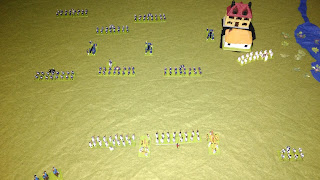And the reason has nothing to do with the paucity of English-language material on the encounter, which saw some 10,000 Frenchmen under the command of the future Duke of Broglie - he received his peerage after the battle - defeat a smaller Austrian force just eight days after Frederick the Great beat the Austrians at Chotusitz.
 |
| Broglie, in understandable high spirits |
Here is the latest summary of my rules, as they will apply at Sahay.
COMMAND & CONTROL
Number of units, divided by 2 (a half is rounded up), gives an army's median card activation value.
MOVEMENT
Foot in firing order and so able to fire volleys: 6cm
Other foot: 8cm
Limbered guns: 6cm
Heavy horse: 10cm
Light horse and generals: 12cm
It takes an activation point to adopt firing order, and the unit may not otherwise move or fire that phase.
Horse take half a phase to mount or dismount.
Guns take an activation point to limber or unlimber, but the gun may be pivoted as part of unlimbering. Guns must be stationary to fire, so may not pivot and fire in the same phase.
One about-face of 180 degrees is free, but a second in the same phase reduces movement by half.
All troops can pass through light infantry without penalty, provided they have enough movement to take them beyond the light infantry. Similarly, light infantry can interpenetrate any friendly troops.
The Variation
Roll a die if a unit is moving three-quarters or more of its maximum move distance. 6, add 25%; 1, subtract 25%.
MUSKETRY
45-degree arc.
Muskets: 8cm. Carbines 6cm.
Roll one die for each 25% of effectiveness remaining and in a single line of bases.
Minimum score for a hit: Regular foot in firing order, 4; Light foot, 5; Dismounted horse and regular foot not in firing order, 6.
-1 if unit moved that phase.
ARTILLERY
45-degree arc.
Canister: 0-6cm. Roll a die and halve the score to get the number of potential hits.
Roundshot: up to 24cm. Roll a die and quarter the score.
Halve the number of potential hits if unit effectiveness 50% or under. Round to nearest fraction, but an exact half has a 50:50 chance of becoming a potential hit.
Dice for each potential hit. 4 or more becomes a hit on infantry and cavalry, but 6 is needed if the target is a gun.
MELEES
A melee happens when the bases of rival units come in contact.
Foot may not initiate contact against horse.
Guns and light foot never initiate contact and never inflict melee casualties (exception: light foot in a wood or built-up area melee as regular foot).
Guns can only be contacted if they have no friendly close-order foot within 4cm. Guns so contacted are automatically eliminated.
Roll the following numbers of dice per 25% of a unit's remaining effectiveness.
Enemy unit...........Hvy Cav...Lance...Lt Cav...Inf fir ord*...Other Inf...Lt Inf
Own unit
Heavy Cavalry.........1................2..........2...............1.................3................2
Lancers.....................1................1..........1...............1.5..............4................4
Light Cavalry...........1................2..........1...............1.................2................3
Inf (not Lt)................1................1.........1................1.................1................1
*Infantry in firing order and attacked frontally
+1 die per 25% when attacking in flank or rear, on higher ground, defending a river bank or defending a built-up area from troops outside the BUA. Bonuses are cumulative. An exact half has a 50:50 chance of becoming a potential hit.
For each die rolled, a 4 or more is a hit.
SAVING THROWS
Behind cover: 4 or more cancels a hit.
Cuirassiers: 6 cancels a hit.
MORALE
Test at the end of any phase in which a unit has lost effectiveness to firing or has lost a melee.
Roll a die, needing the following minimum score not to lose a further 25% effectiveness.
Elite, 3; Regular, 4; Poor, 5.
+1 if a general is attached to the unit. He is eliminated if the unit is eliminated.
+1 if a friendly unit (not light infantry or guns) is to the rear and could reach the unit in two moves.
A unit that fails its morale, and a unit that loses more hits in a melee regardless of whether it fails its morale, retreats one move (with the normal possible variation), ending with its back to the enemy.
A retreating unit is eliminated if the first move of a retreat is obstructed by regular foot (not light infantry) or horse. If the blocking unit is friendly, it must take a morale test unless its horse retreated into by foot.
On subsequent phases in which a retreating unit's army has activation points, it will be rallied for at the start of the phase, requiring a 5 or better to halt and being able to subsequently return to normal action. A general with a unit adds one to the rallying throw.
Note that regular foot lose firing order when retreating and so have an 8cm move.
VICTORY
General, 3pts; Infantry battalion, 2pts, Other unit, 1pt.
Army is defeated when points fall below half the starting total.
























